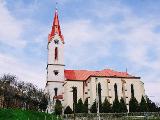Ardud - The Roman Catholic Church of “The Assumption of the Holy Virgin”
Document tools
 The town of Ardud is situated at the bottom of the Codru Hills. As the center of the royal forest-domain, it had an important administrative and ecclesiastical role during the 13th century. The priest of Ardud was directly subordinated to the Bishop of Transylvania as an archdean. According to the papal tithes of the 14th century, however, the settlement was part of the deanery of Satu Mare at that time. There is little information on the medieval church, except of few descriptions from the 19th century. These allow dating some of the carved stones to the Romanic period. The Drăgoşeşti family became the owner of the settlement during the 14th century. They started to build a new church, and, on the northern side of it, a new crypt for the family members, in 1483. Parallel to the new church, a castle was built nearby. The last descendent of Drăgoşeşti family, Gaspar,
The town of Ardud is situated at the bottom of the Codru Hills. As the center of the royal forest-domain, it had an important administrative and ecclesiastical role during the 13th century. The priest of Ardud was directly subordinated to the Bishop of Transylvania as an archdean. According to the papal tithes of the 14th century, however, the settlement was part of the deanery of Satu Mare at that time. There is little information on the medieval church, except of few descriptions from the 19th century. These allow dating some of the carved stones to the Romanic period. The Drăgoşeşti family became the owner of the settlement during the 14th century. They started to build a new church, and, on the northern side of it, a new crypt for the family members, in 1483. Parallel to the new church, a castle was built nearby. The last descendent of Drăgoşeşti family, Gaspar, embraced the Reform and his widow housed a Protestant synod in Ardud, in 1545. During the siege of the castle in 1565, the church was damaged, and the soldiers opened and profaned the family crypt. The Calvinist community was the single user of the church at the beginning of the 18th century, but Alexander Károlyi decreed the common use of the church by the Calvinist Hungarians and the, recently settled Catholic Schwabs, in the 1720s. The mediaeval vestry was unified with the northern side-chapel and separated from the rest of the church, creating in this way a new space for the Catholics. The relation between the two communities, together using the same building, deteriorated over the next decades. Therefore, Antal Károlyi gave the whole church to the Catholics, in 1766. An earthquake from 1834 damaged the church, and it had to be reconstructed in 1860, with financial help from Lajos Károlyi. The present building is in neo-gothic style. The hall-like nave has a plain ceiling and a polygonal sanctuary. On the northern side of the sanctuary a vestry is added, with an oratorio on the upper level. The outer façade is dominated by the buttresses and the pointed-arch windows. The western tower was built at the same time with the new church. The main altar is made in neo-gothic style and the central painting represents The Assumption of the Holy Virgin, dated in the 19th century. The altar of the northern side nave dates from the 18th century and depicts the image of The Birth of Jesus. (TSz).
embraced the Reform and his widow housed a Protestant synod in Ardud, in 1545. During the siege of the castle in 1565, the church was damaged, and the soldiers opened and profaned the family crypt. The Calvinist community was the single user of the church at the beginning of the 18th century, but Alexander Károlyi decreed the common use of the church by the Calvinist Hungarians and the, recently settled Catholic Schwabs, in the 1720s. The mediaeval vestry was unified with the northern side-chapel and separated from the rest of the church, creating in this way a new space for the Catholics. The relation between the two communities, together using the same building, deteriorated over the next decades. Therefore, Antal Károlyi gave the whole church to the Catholics, in 1766. An earthquake from 1834 damaged the church, and it had to be reconstructed in 1860, with financial help from Lajos Károlyi. The present building is in neo-gothic style. The hall-like nave has a plain ceiling and a polygonal sanctuary. On the northern side of the sanctuary a vestry is added, with an oratorio on the upper level. The outer façade is dominated by the buttresses and the pointed-arch windows. The western tower was built at the same time with the new church. The main altar is made in neo-gothic style and the central painting represents The Assumption of the Holy Virgin, dated in the 19th century. The altar of the northern side nave dates from the 18th century and depicts the image of The Birth of Jesus. (TSz). Printable version
Printable version
 Send as email
Send as email
